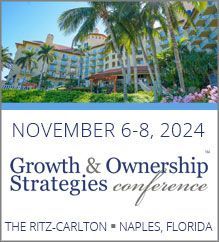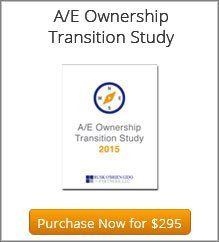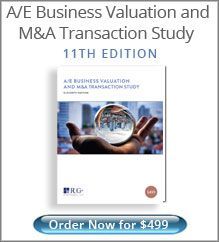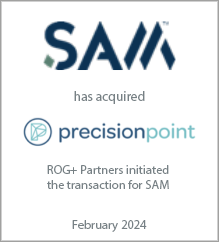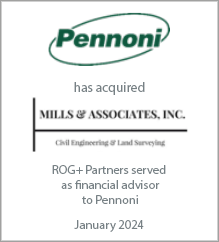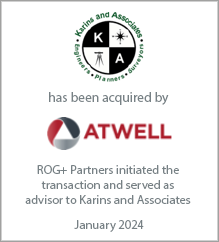Steve Gido specializes in corporate financial advisory services with a focus on mergers and acquisitions. Steve has assisted architecture, engineering, environmental consulting and construction firms of all sizes across North America achieve their growth or liquidity goals through successful mergers & acquisitions. Steve has over 15 years of investment banking experience and holds the chartered financial analyst (CFA) designation from the CFA Institute.
2011 A/E M&A Outlook — The Long Road Back
2011 A/E M&A Outlook — The Long Road Back
March 3, 2011
After back-to-back years of tepid deal making amid the worst design recession in recent memory, the M&A market for A/E and environmental consulting firms has shown surprising signs of life to start 2011. As we reported last summer, activity began to accelerate in earnest across all disciplines, led by the publicly traded E&C companies, and has now begun to broaden and pick up momentum. In fact, activity through the first two months of 2011 is up 50% over 2009 and 2010 levels and is comfortably back to the pre-bubble levels of 2007 and 2008. Large firm consolidation has paralleled niche and tuck-in deals over the last 9 months and growth and risk seems to be back in vogue again (thankfully!).
We were slightly taken aback by the suddenness of this recent wave because frankly we have been witnessing a mixed bag of industry forecasts, underlying financial performances, and management and strategic intentions across the industry. While on the one hand we are pleased by the steady, albeit sidestep, movement in the AIA billings index as well as the recent levels of the publicly traded E&C stocks (most prominently led by the energy infrastructure firms), the reality of new austerity measures sweeping through federal and state budgets and the ramifications for U.S. infrastructure spending is cause for concern. CEO confidence, always the fan to the M&A flame, has been hard to decipher after two years of borderline glum psychology.
Unlike this last decade, where the rising design and building tide lifted all boats, this recession has seen its share of winners and losers emerge. Despite the drumbeat of bad news, there have been many A/E and environmental organizations that have been doing extremely well. In fact in many cases 2010 was a record year for firms that benefited from foresight, timing, or just plain luck. To be sure, these management teams read the tea leaves, had lived through down cycles before, and made the painful operational efficiencies to prepare for this downturn. However, many also positioned themselves in growing, or at least not shrinking, sectors, such as federal, renewable energy or green building. Others took advantage of just being in the right place at the right time, such as the gold rush atmosphere surrounding Marcellus Shale development, or in states that don’t recognize a recession when they see it (North Dakota’s unemployment rate is still under 4%!).
However, other A/E organizations have struggled mightily over the last 3 years, with many firms shells of their former ebullient selves. These organizations have either struggled with commercial building and credit crunches that are slow to recover, located in states that have been hard hit by the building bust, or face some dreaded combination of slow collections, high fixed cost base, pricey office real estate, and rising debt balances.
So as a sign of the times, many Presidents and Principals we have spoken with are expressing optimism, albeit with a higher degree of humility and caveats. Most realize that the overall economy is indeed improving and that the risks of a “double dip” have receded for now. However, many are tracking backlog and pipeline opportunities with a sharpened sense of purpose, as the competitive environment remains unforgiving, with still too many engineers, architects, and planners chasing too few projects for their liking. Nothing is being taken for granted.
So with a general industry overview as background, how does the rest of the year potentially shape up for buyers and sellers?
Buyers – Ready to Pounce?
At ROG + Partners, we’ve started 2011 by speaking with countless Presidents, Principals, CFOs, and Corporate Development teams, in the U.S. and overseas, across industry and size spectrums to gauge their M&A interests and criteria. The one overriding theme we’ve taken away is that buyers today are seeking well run firms that fit specific niches, rather than multi-disciplinary firms or studios purely for scale. That is particularly true with many of the U.S. publicly traded E&C firms. These organizations have gone on a buying binge like no other the last decade, scooping up some of the country’s most venerable A/E and environmental names.
Now as domestic markets mature, these M&A teams are focusing their attentions away from the U.S. and towards energy and infrastructure targets with burgeoning capital expenditures opportunities in emerging markets like Asia, Middle East, Australia, Africa, and South America. Flush with cash, these companies are seeking well positioned firms with transportation, mining, water, hydropower, energy, upstream oil & gas, asset management, and environmental (sustainability, climate change, etc.) capabilities. We expect the energy infrastructure firms in particular to continue with aggressive share repurchase programs as well as ramping up their M&A initiatives. With many E&C stocks at 52-week highs and borrowing rates as low as we’ll see them, the publicly traded firms will be active for a while.
On the other hand, like two ships criss-crossing each other, the large international multi-discipline firms from Canada, Australia, and Europe continue to push their way into the U.S., evaluating both platform and add-on capabilities to their existing global franchises. They continue to see the long-term potential and geographic diversity from having a U.S. presence. From their perspective, it simply takes too long and the opportunity costs are too large to effectively cold start operations here from scratch.
Our conversations with privately held A/E and environmental firms, those generating between $25 and $250 million in revenue, yielded little in the way of consensus. A good number of Boards are focusing on growth activities again but realize fundamentally that means taking market share away in a slower growth economy. As a result, they are getting their pipelines active again and initiating target search activities in earnest. Other firms are taking a more of a “wait and see” approach given either a lower risk appetite, digesting deals from the last two years, or waiting until the economy and building and infrastructure outlook gets sustained traction. While many buyers would (under the right deal structure!) certainly look at an underperforming firm with a great brand, the majority of buyers today are still steering clear of turnarounds, bargains, and distressed scenarios.
Sellers – Should I Stay or Should I Go?
Industry demographics and leadership succession issues continue to play a more prominent role every year (many A/E executive teams remain top heavy and in their mid-to-late 50s) in our strategic and ownership alternative studies. Add looming stock redemption liabilities, a shrinking internal buyer pool, and higher valuations in an external sale, and the “sell down” or “sell out” decision has become a growing source of concern for owners. Sellers are emerging, in some cases out of weak performance and for pure sustainability and survivability measures, while others in growing or resilient sectors realize the timing and valuation environment is favorable for them (throw in the recent reprieve on capital gain tax hikes as well). Valuations are attractive in the above mentioned “hot” niche markets but buyers remain disciplined in regards to strengths of backlog, structure, employment considerations, indemnification, and diligence activities. Of course, owners need to rationally understand what they could earn by selling shares internally, remaining independent, or cashing out to a larger entity.
In fact, the critical element from our discussions with owners struggling with transition challenges and a potential sale process is indeed timing. If the U.S. economy and design climate were heading towards a “V” shaped recovery and outlook, many owners would simply continue to ride this cycle out and wait until their underlying performance snapped back along with design and construction activity. Unfortunately in a “W” or “L” or whatever shaped recovery this is, many A/E owners don’t have a sense of whether they should sell tomorrow or hang in there for a few more years.
The A/E and environmental competitive landscape will continue to change in 2011 as mega combinations and niche deals accelerate a consolidating industry. We’re encouraged that when properly planned and communicated, and when cultures and design philosophies are aligned, M&A can be a powerful method for strategic growth and ownership transition. At Rusk O’Brien Gido + Partners, we possess years of experience navigating A/E and environmental buyers and sellers through the M&A process and towards winning combinations.
Please feel free to give me a call if you’re considering a merger or acquisition; I’d be happy to give you my candid thoughts and observations as to what we’re seeing so far this year.
We were slightly taken aback by the suddenness of this recent wave because frankly we have been witnessing a mixed bag of industry forecasts, underlying financial performances, and management and strategic intentions across the industry. While on the one hand we are pleased by the steady, albeit sidestep, movement in the AIA billings index as well as the recent levels of the publicly traded E&C stocks (most prominently led by the energy infrastructure firms), the reality of new austerity measures sweeping through federal and state budgets and the ramifications for U.S. infrastructure spending is cause for concern. CEO confidence, always the fan to the M&A flame, has been hard to decipher after two years of borderline glum psychology.
Unlike this last decade, where the rising design and building tide lifted all boats, this recession has seen its share of winners and losers emerge. Despite the drumbeat of bad news, there have been many A/E and environmental organizations that have been doing extremely well. In fact in many cases 2010 was a record year for firms that benefited from foresight, timing, or just plain luck. To be sure, these management teams read the tea leaves, had lived through down cycles before, and made the painful operational efficiencies to prepare for this downturn. However, many also positioned themselves in growing, or at least not shrinking, sectors, such as federal, renewable energy or green building. Others took advantage of just being in the right place at the right time, such as the gold rush atmosphere surrounding Marcellus Shale development, or in states that don’t recognize a recession when they see it (North Dakota’s unemployment rate is still under 4%!).
However, other A/E organizations have struggled mightily over the last 3 years, with many firms shells of their former ebullient selves. These organizations have either struggled with commercial building and credit crunches that are slow to recover, located in states that have been hard hit by the building bust, or face some dreaded combination of slow collections, high fixed cost base, pricey office real estate, and rising debt balances.
So as a sign of the times, many Presidents and Principals we have spoken with are expressing optimism, albeit with a higher degree of humility and caveats. Most realize that the overall economy is indeed improving and that the risks of a “double dip” have receded for now. However, many are tracking backlog and pipeline opportunities with a sharpened sense of purpose, as the competitive environment remains unforgiving, with still too many engineers, architects, and planners chasing too few projects for their liking. Nothing is being taken for granted.
So with a general industry overview as background, how does the rest of the year potentially shape up for buyers and sellers?
Buyers – Ready to Pounce?
At ROG + Partners, we’ve started 2011 by speaking with countless Presidents, Principals, CFOs, and Corporate Development teams, in the U.S. and overseas, across industry and size spectrums to gauge their M&A interests and criteria. The one overriding theme we’ve taken away is that buyers today are seeking well run firms that fit specific niches, rather than multi-disciplinary firms or studios purely for scale. That is particularly true with many of the U.S. publicly traded E&C firms. These organizations have gone on a buying binge like no other the last decade, scooping up some of the country’s most venerable A/E and environmental names.
Now as domestic markets mature, these M&A teams are focusing their attentions away from the U.S. and towards energy and infrastructure targets with burgeoning capital expenditures opportunities in emerging markets like Asia, Middle East, Australia, Africa, and South America. Flush with cash, these companies are seeking well positioned firms with transportation, mining, water, hydropower, energy, upstream oil & gas, asset management, and environmental (sustainability, climate change, etc.) capabilities. We expect the energy infrastructure firms in particular to continue with aggressive share repurchase programs as well as ramping up their M&A initiatives. With many E&C stocks at 52-week highs and borrowing rates as low as we’ll see them, the publicly traded firms will be active for a while.
On the other hand, like two ships criss-crossing each other, the large international multi-discipline firms from Canada, Australia, and Europe continue to push their way into the U.S., evaluating both platform and add-on capabilities to their existing global franchises. They continue to see the long-term potential and geographic diversity from having a U.S. presence. From their perspective, it simply takes too long and the opportunity costs are too large to effectively cold start operations here from scratch.
Our conversations with privately held A/E and environmental firms, those generating between $25 and $250 million in revenue, yielded little in the way of consensus. A good number of Boards are focusing on growth activities again but realize fundamentally that means taking market share away in a slower growth economy. As a result, they are getting their pipelines active again and initiating target search activities in earnest. Other firms are taking a more of a “wait and see” approach given either a lower risk appetite, digesting deals from the last two years, or waiting until the economy and building and infrastructure outlook gets sustained traction. While many buyers would (under the right deal structure!) certainly look at an underperforming firm with a great brand, the majority of buyers today are still steering clear of turnarounds, bargains, and distressed scenarios.
Sellers – Should I Stay or Should I Go?
Industry demographics and leadership succession issues continue to play a more prominent role every year (many A/E executive teams remain top heavy and in their mid-to-late 50s) in our strategic and ownership alternative studies. Add looming stock redemption liabilities, a shrinking internal buyer pool, and higher valuations in an external sale, and the “sell down” or “sell out” decision has become a growing source of concern for owners. Sellers are emerging, in some cases out of weak performance and for pure sustainability and survivability measures, while others in growing or resilient sectors realize the timing and valuation environment is favorable for them (throw in the recent reprieve on capital gain tax hikes as well). Valuations are attractive in the above mentioned “hot” niche markets but buyers remain disciplined in regards to strengths of backlog, structure, employment considerations, indemnification, and diligence activities. Of course, owners need to rationally understand what they could earn by selling shares internally, remaining independent, or cashing out to a larger entity.
In fact, the critical element from our discussions with owners struggling with transition challenges and a potential sale process is indeed timing. If the U.S. economy and design climate were heading towards a “V” shaped recovery and outlook, many owners would simply continue to ride this cycle out and wait until their underlying performance snapped back along with design and construction activity. Unfortunately in a “W” or “L” or whatever shaped recovery this is, many A/E owners don’t have a sense of whether they should sell tomorrow or hang in there for a few more years.
The A/E and environmental competitive landscape will continue to change in 2011 as mega combinations and niche deals accelerate a consolidating industry. We’re encouraged that when properly planned and communicated, and when cultures and design philosophies are aligned, M&A can be a powerful method for strategic growth and ownership transition. At Rusk O’Brien Gido + Partners, we possess years of experience navigating A/E and environmental buyers and sellers through the M&A process and towards winning combinations.
Please feel free to give me a call if you’re considering a merger or acquisition; I’d be happy to give you my candid thoughts and observations as to what we’re seeing so far this year.
Latest Perspective
Perfecting the A/E Exit Strategy – Five Key Factors
An enormous A/E generation that kicked off their careers in the 1980s and subsequently started firms or became owners in the 1990s ...
© 2024
Rusk O'Brien Gido + Partners, LLC
Financial Experts for Architects, Engineers, and Environmental Consulting Firms


